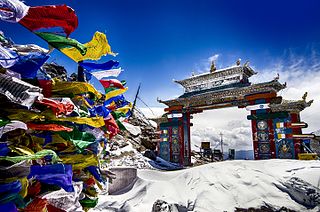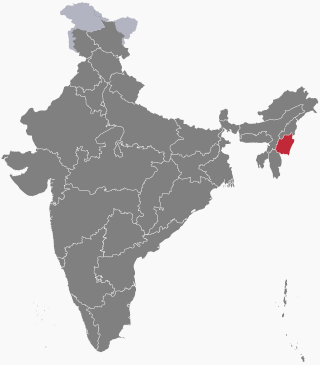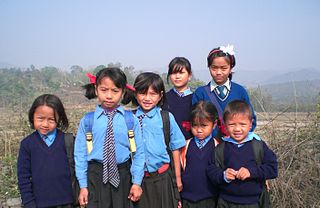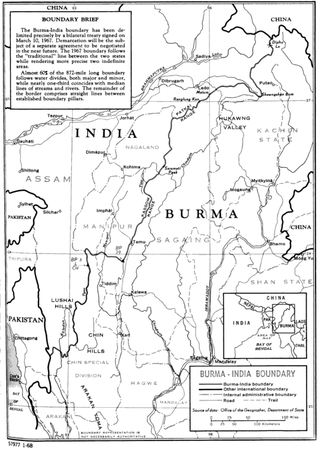
Manipur is a landlocked state in northeast India with Imphal as its capital. It borders Assam to the west, Mizoram to the south, and Nagaland to the north. It shares international borders with Myanmar, specifically the Sagaing Region to the east and Chin State to the southeast. Covering an area of 8,621 square miles, the state consists mostly of hilly terrain with the 700-square-mile Imphal Valley inhabited by the Meitei (Manipuri) community, historically a kingdom. Surrounding hills are home to Naga and Kuki-Zo communities, who speak Tibeto-Burman languages. The official language and lingua franca, Meitei (Manipuri), also belongs to the Tibeto-Burman family.

Northeast India, officially the North Eastern Region (NER), is the easternmost region of India representing both a geographic and political administrative division of the country. It comprises eight states—Arunachal Pradesh, Assam, Manipur, Meghalaya, Mizoram, Nagaland and Tripura, and the "brother" state of Sikkim.

The Insurgency in Northeast India involves multiple separatist and jihadist militant groups operating in some of India's northeastern states, which are connected to the rest of India by the Siliguri Corridor, a strip of land as narrow as 14.29 miles (23.00 km) wide.

Nagas are various Southeast Asian Tibeto-Burman ethnic groups native to northwestern Myanmar and northeastern India. The groups have similar cultures and traditions, and form the majority of population in the Indian state of Nagaland and Naga Self-Administered Zone of Myanmar (Burma); with significant populations in Manipur, Arunachal Pradesh and Assam in India; Sagaing Region and Kachin State in Myanmar.
The Paite people are an ethnic group in Northeast India, mainly living in Manipur and Mizoram. The Paites are recognized as a scheduled tribe in these two states. They are part of the larger Zo people, but also use their Zomi identity along with all the 7 tribes under "Zomi Council". "Guite" is a major clan of the Paite people.

The Kuki people, or Kuki-Zo people, are an ethnic group in the Northeastern Indian states of Manipur, Nagaland, Assam, Meghalaya, Tripura and Mizoram, as well as the neighbouring countries of Bangladesh and Myanmar. The Kukis form one of the largest hill tribe communities in this region. In Northeast India, they are present in all states except Arunachal Pradesh. The Chin people of Myanmar and the Mizo people of Mizoram are kindred tribes of the Kukis. Collectively, they are termed the Zo people.

Gaidinliu Pamei popularly known as Rani Gaidinliu was an Indian Naga spiritual and freedom fighter, political leader who led a revolt against British rule in India. At the age of 13, she joined the Heraka religious movement of her cousin Haipou Jadonang. The movement later turned into a political movement seeking to drive out the British from Manipur. Within the Heraka faith, she came to be considered an incarnation of the Goddess Cherachamdinliu. Gaidinliu was arrested in 1932 at the age of 16, and was sentenced to life imprisonment by the British rulers. Jawaharlal Nehru met her at Shillong Jail in 1937, and promised to pursue her release. Nehru gave her the title of "Rani" ("Queen"), and she gained local popularity as Rani Gaidinliu.
Moreh is a border town located on the India–Myanmar border in Tengnoupal district of the Indian state of Manipur. As a rapidly developing international trade point with the integrated customs and international immigration checkpoint, Moreh plays an important role in India's Look East Policy, trade and commerce under ASEAN–India Free Trade Area, India-Myanmar relationship, India–Myanmar–Thailand road connectivity, and Trans-Asian Railway connectivity.

The National Socialist Council of Nagaland (NSCN) is a Naga militant and separatist group operating mainly in northeastern part of India, with minor activities in northwest Myanmar (Burma). The main aim of the organisation is allegedly to establish a sovereign Naga state, "Nagalim", which would consist of all the areas inhabited by Naga tribes in Northeast India and northwest Myanmar. Despite the name, the group does not endorse the ideology of "National Socialism" as practiced by Nazi Germany. Rather, the group's name is derived from their belief in the nationalist goal of a sovereign Naga state, combined with their belief in socialism. Due to the area the Naga traditionally inhabit being relatively isolated, the combination of the terms "nationalism" and "socialism" together do not have the same association with Nazism as it does in the Western world. India claims that China and Pakistan provide financial support and weaponry to the NSCN. Drug trafficking and extortion are believed to be other major sources of income for the NSCN.
Naga nationalism is an ideology that supports the self-determination of the Naga people in India and Myanmar, and the furtherance of Naga culture.

The Zomi Revolutionary Army (ZRA) is an armed Zomi nationalist militant group formed in 1997, following an increase in ethnic tensions between the Kuki people and the Paite people in Churachandpur district of Manipur, India. Its parent organisation, the Zomi Re-unification Organisation, was founded in April 1993.
The Zo people is a term to denote the ethnolinguistically related speakers of the Kuki-Chin languages who primarily inhabit northeastern India, western Myanmar, and southeastern Bangladesh.
The northeastern Indian state of Manipur has a relatively large population of Tamils, largely concentrated near the border of Myanmar. The town of Moreh in particular has an estimated 17,000 Tamils. Tamils in Manipur have relatives and business contacts in Myanmar, which is a valuable network facilitating cross-border trade.
Secession in India typically refers to state secession, which is the withdrawal of one or more states from the Republic of India. Whereas, some have wanted a separate state, union territory or an autonomous administrative division within India. Many separatist movements exist with thousands of members, however, some have low local support and high voter participation in democratic elections. However, at the same time, demanding separate statehood within under the administration of Indian union from an existing state can lead to criminal charges under secession law in India. India is described as a ‘Union of States’ in Article 1 of the Indian constitution I.e "Indestructible nation of destructible states" by its father of constitution Dr. Bhimrao Ramji Ambedkar where a state or Union territory of India cannot secede from India by any means and the Central Government has more powers than the respective state governments and can forcefully change the names and boundaries of the states without their permission at any time when needed for self interest and for the maintenance of integrity.

The Insurgency in Manipur is an ongoing armed conflict between India and a number of separatist rebel groups, taking place in the state of Manipur. The Insurgency in Manipur is part of the wider Insurgency in Northeast India; it displays elements of a national liberation war as well as an ethnic conflict.

The hill tribes of Northeast India are hill people, mostly classified as Scheduled Tribes (STs), who live in the Northeast India region. This region has the largest proportion of scheduled tribes in the country.

The India–Myanmar border is the international border between India and Myanmar. The border is 1,643 kilometres (1,021 mi) in length and runs from the tripoint with China in the north to the tripoint with Bangladesh in the south.
In the state of Manipur in northeast India, conflict arose between the Kukis and Nagas soon after India's independence. The Nagas, who dominated the northern hill regions of the state, attempted to homogenise the area in order to demand integration with the Naga Hills region further north. This caused displacement of Kukis to the southern districts as well as the central hill regions during the 1950s. Major clashes again occurred during 1992-98, leading to the deaths of more than 1,000 people and diplacement of 50,000–100,000 people.

The Rising People's Party (RPP) is a political party of Nagaland, India founded by Joel Naga in 2021. The motto of the party is “For Freedom and Democracy”. The party seeks autonomy and federal status for Nagaland. RPP supported S. Supongmeren Jamir of Indian National Congress during the 2024 Lok Sabha election, and the Party is allied with the Congress party. In the 2023 Legislative Assembly election, the party fielded a single candidate in Tseminyu district. In 2024, the party indicated support for maintaining the free movement regime and opposed the construction of fencing along the India–Myanmar border as divisive for ethnic groups of the Northeast.

Throughout the long-running separatist insurgencies in Northeast India, dozens of India-based insurgent groups have been involved in the neighboring conflict in Myanmar, both sheltering in Myanmar from the counterinsurgent Assam Rifles and participating in the conflict itself. Outside of several Indian-led operations, including Operation Golden Bird in 1995, Operation Hot Pursuit in 2015, or Operation Sunrise I and II in 2019, areas in which these insurgent groups are active have scarcely experienced fighting. Amid the escalation of civil war in Myanmar from 2021, several sources claim that the majority of Indian ethnic armed organisations (IEAOs) are allied, or have some level of understanding, with the ruling military junta of Myanmar, who allows them to maintain bases inside mountainous areas of northern Myanmar, typically in return for the IEAOs attacking anti-junta resistance groups.










